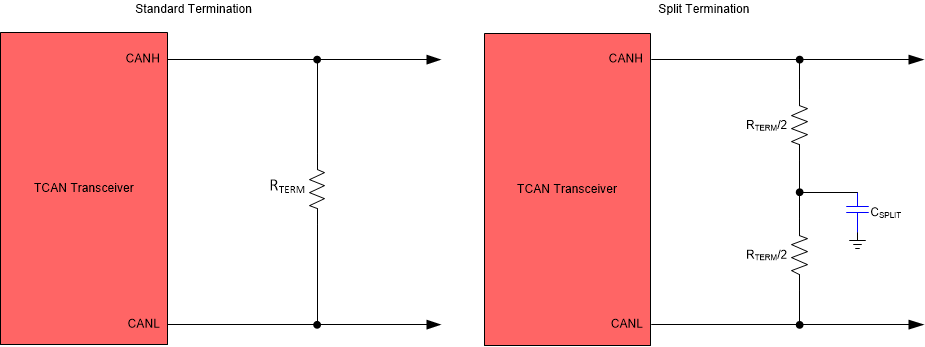JAJSV04A July 2024 – November 2024 TCAN1043N-Q1
ADVANCE INFORMATION
- 1
- 1 特長
- 2 アプリケーション
- 3 概要
- 4 Pin Configuration and Functions
- 5 Specifications
- 6 Parameter Measurement Information
-
7 Detailed Description
- 7.1 Overview
- 7.2 Functional Block Diagram
- 7.3
Feature Description
- 7.3.1 Supply Pins
- 7.3.2 Digital Inputs and Outputs
- 7.3.3 GND
- 7.3.4 INH Pin
- 7.3.5 WAKE Pin
- 7.3.6 CAN Bus Pins
- 7.3.7
Faults
- 7.3.7.1 Internal and External Fault Indicators
- 7.3.8 Local Faults
- 7.4 Device Functional Modes
- 8 Application Information Disclaimer
- 9 Device and Documentation Support
- 10Revision History
- 11Mechanical, Packaging, and Orderable Information
パッケージ・オプション
メカニカル・データ(パッケージ|ピン)
サーマルパッド・メカニカル・データ
- DMT|14
発注情報
8.1.3.1 CAN Termination
Termination may be a single 120Ω resistor at each end of the bus, either on the cable or in a terminating node. If filtering and stabilization of the common-mode voltage of the bus is desired then split termination may be used, see Figure 8-2. Split termination improves the electromagnetic emissions behavior of the network by filtering higher-frequency common-mode noise that may be present on the differential signal lines.
 Figure 8-2 CAN Bus Termination Concepts
Figure 8-2 CAN Bus Termination Concepts